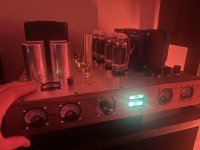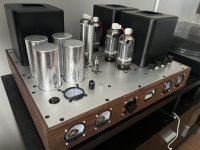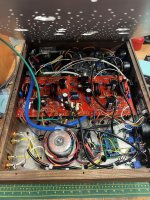I thought there was a thread for the unadulterated version but I can't find it. For now I'm doing the standard build and have a question.
Im talking to Landfall systems about a chassis and they were able to work well with the CAD file from Pete Millett's site. I was thinking of adding two meters to the front for bias and balance adjustments. 4 would not look nice to me. I'd just use a 3 pole double throw switch to alternate the meters from the test points on the left and right channels. For anyone that has been using and living with this amp, does that seem like an addition worth the effort. Aside from what Landfall will charge for the openings it will be an additional $20 tops for the switch and meters. Ill be sure to have holes in the top plate as well for a screwdriver. Without that it makes no sense.
Any thoughts.
Im talking to Landfall systems about a chassis and they were able to work well with the CAD file from Pete Millett's site. I was thinking of adding two meters to the front for bias and balance adjustments. 4 would not look nice to me. I'd just use a 3 pole double throw switch to alternate the meters from the test points on the left and right channels. For anyone that has been using and living with this amp, does that seem like an addition worth the effort. Aside from what Landfall will charge for the openings it will be an additional $20 tops for the switch and meters. Ill be sure to have holes in the top plate as well for a screwdriver. Without that it makes no sense.
Any thoughts.
The original thread is here : https://www.diyaudio.com/community/threads/posted-new-p-p-power-amp-design.151206/
Yes the bias meters are a good idea, I once had a diying tube that I only noticed very late when the amp made a horrid noise on a channel. Then with only 2 meters for 4 tubes, I would maybe not have noticed earlier if the switch would have shown the bias of the good tube.
I sometimes think about offering such measurement points to a socket on the back, and connecting a small multi channel ADC arduino alerting me when things go wrong, counting the usage hours, etc.
Yes the bias meters are a good idea, I once had a diying tube that I only noticed very late when the amp made a horrid noise on a channel. Then with only 2 meters for 4 tubes, I would maybe not have noticed earlier if the switch would have shown the bias of the good tube.
I sometimes think about offering such measurement points to a socket on the back, and connecting a small multi channel ADC arduino alerting me when things go wrong, counting the usage hours, etc.
Been travelling for work, so couldn’t work on the amp for a bit, but I’ve been back a few days and I got it mostly finished. Still need to dissemble it to anodize the top plate. Need to finish the transformer covers, and I need to add feet. Thinking about some back lights for the gauges and dimming the power button light as well.
Here’s a quick video of it in operation. Just hooked into my small speakers right now, but they sound pretty nice.
YouTube video
Here’s a quick video of it in operation. Just hooked into my small speakers right now, but they sound pretty nice.
YouTube video
Attachments
I, once I'm finished with the engineers amp, am going to build the monoblocks. I have cases from Landfall and all parts except transformers. It's got me wondering if I should look to build the higher powered version straight away. I will admit that I'm light on knowledge. So following the original build and the bulk of the experience has its merits. I'm just know how expensive the transformers are either way and wonder if I'll be compelled to upgrade later.
Any advice. Are there any downsides to the more powerful build. I do have relatively sensitive speakers that I built. 2PI towers, 3 Pi and 3 PI subs. Have interest in some large single drivers next.
Any advice. Are there any downsides to the more powerful build. I do have relatively sensitive speakers that I built. 2PI towers, 3 Pi and 3 PI subs. Have interest in some large single drivers next.
Yup, sounds great.Just hooked into my small speakers right now, but they sound pretty nice.

jeff


